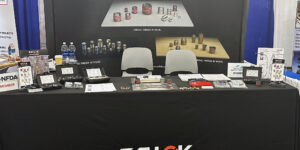INTRODUCTION TO LINEAR ACTUATORS (Part Two)
HaydonKerk Motion Solutions concludes this two-part series with a technical explanation of how to accurately size a linear actuator.
Posted: March 12, 2010
In Part One of this series (see Maintenance, January 2010), we discussed the basics of a stepper motor-based linear actuator, one of the most effective ways to convert rotary into linear motion for a wide range of applications. In Part 2, we will explain how to accurately size a linear actuator.
HOW IS A LINEAR ACTUATOR SIZED?
Sizing a linear actuator is quite easy once you understand the basic needs of the application. The following is the minimum information needed to begin sizing the proper device:
(1) Linear force needed to move the load, expressed in Newtons (N)
(2) Linear distance the load needs to be moved, expressed in meters (M)
(3) Time required to move the load, expressed in seconds (s)
(4) Table 1 (see illustratation)
(5) Performance curves illustrated in Haydon linear actuator catalogs
POWER REQUIREMENTS
The power required to meet the application is now calculated using the parameters above. This will allow the user to easily choose the correct motor framesize needed. (See Formula 1)
Once the power is known in watts, choose the proper frame size of the actuator as listed in Table 1. All stepper motor linear actuators require a drive to send the pulses to the motor. As seen in Table 1, the power for both an L/R drive and a chopper drive is listed. Most applications today use an electronic chopper drive. Unless the application is battery-powered (as in a handheld portable device), a chopper drive is highly recommended to get maximum performance from the linear actuator.
VELOCITY
After calculating the mechanical power needed to meet the application requirements, the linear velocity in inches per second is calculated using the equation in Formula 2.
FORCE VS. LINEAR VELOCITY CURVES
Once the required actuator frame size is determined and the linear velocity is calculated, the ?force vs. linear velocity curve? is used to determine the proper resolution of the actuator lead screw. (See Figure 1)
ACTUATOR LIFE
There are many variables that ultimately determine life of the actuator. The best way to predict life is through application testing, which is highly recommended. There is, however, a first approximation technique that can help estimate this value. The stepper-motor prime mover contains no brushes to wear out and also utilizes precision, long-life ball bearings. The main wear component is the power nut. The number of cycles can be summarized as a function of load, as illustrated in Figure 2.
Example #1
Application Requirements:
Req?d Force (lbs) = 15 lbs
Req?d Travel (in) = 3 in
Time To Achieve Travel (s) = 6 s
Desired Cycles = 1,000,000
Linear Velocity (in/s) = 3 in/6 s = 0.5 in/s
COMPUTATION: Calculate the initial rated force based on required # of cycles:
Step 1
Refer to Figure 2 and determine the correct sizing factor needed in order for the actuator to achieve the required 1,000,000 cycles. This is illustrated with the blue line in Figure 3.
Step 2
As indicated in the chart, in order to get 1,000,000 cycles, a factor of 0.5 must be used when sizing the actuator. The initial rated force required in order to meet the load after 1,000,000 cycles is therefore:
15 lbs / 0.5 = 30 lbs
Step 3
Convert lbs to Newtons (N):
30 lbs / (0.225 lbs / N) = 133 N
COMPUTATION: Determine required travel in meters
3 in x (0.0254 M / in) = 0.0762 M
COMPUTATION: Choose the proper frame size actuator using the selector chart
Step 1
Determine the required linear mechanical power in watts:
P linear = (133N x 0.0762M) / 6s = 1.7 N-M / s = 1.7 watts
Step 2
Use Table 1 to determine the correct frame size actuator. As discussed earlier, most applications will use a chopper drive to supply the required input pulses to the stepper motor. The 43000 (Size 17 Hybrid) was chosen for this application, as highlighted in the ?Hybrid Single Stack? section of Table 1A.
COMPUTATION: Determine the proper resolution using the ?Force vs Linear Velocity? chart
As determined by the life calculation performed above, an initial load of 30 lbs is to be moved at a velocity of 0.5in/s. The resulting lead screw resolution required in the Size 17 hybrid motor is 0.00048? (J resolution), as indicated in Figure 4.
COMPUTATION: Verify selection by checking force at the required step rate
Earlier in the paper, it was discussed that the lead screw advances based on the number of input steps to the motor. Haydon performance curves are expressed in both ?in/sec? (as illustrated in Figure 4) and also in ?steps/sec? (Figure 5). As an effective check, verify the selection by checking the force at the required step rate.
Resolution chosen = 0.00048 in/step (?J? screw)
Req?d linear velocity = 0.5 in/s
Req?d step rate = 0.5 in/s) / (0.00048 in/step) = 1041 steps/s
Figures 4 and 5 are good illustrations of how the pulses to the stepper motor translate into linear motion through the lead screw.
CONCLUSION
Through the use of stepper motor-based linear actuators, rotary-to-linear motion takes place inside the motor itself. This method offers unique advantages over alternative approaches, such as fewer components, smaller overall footprint size, high force output, and long stroke lengths. What?s more, the high precision, repeatability, long component are especially attractive, as are the high resolutions possible.
In addition, the use of the stepper motor translates to a lower overall cost for OEM equipment builders in terms of development and production. Most importantly, this method can be utilized in a variety of vertical markets, including medical, laboratory instrumentation, semiconductor, aerospace, and virtually any other application where precision linear motion is required.
HaydonKerk Motion Solutions is the joining of two world class brands in the field of linear motion; Haydon? and Kerk®. Together, the company now offers a broad range of precision linear motion products. Recognized as a leading manufacturer of stepper motor based linear actuators, rotary motors, lead screw assemblies, and linear rail and guide systems used in niche market applications, this manufacturer offers high performance with its range of reliable, precise designs.
– – – – – – – – – – – – – – – – – – – – – – – – – – – – – – – – – – – – – – – – –
HaydonKerk Motion Solutions, 1500 Meriden Road Waterbury, CT 06705, 203-756-7441, Fax: 203-756-8724, www.HaydonKerk.com.









